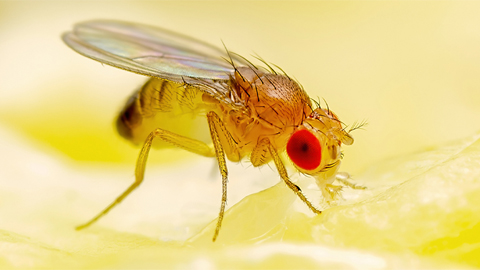From the Journals: JBC
Maternal metabolite promotes offspring survival. Unraveling the tick’s blood-sucking strategy. Connecting obesity and liver diseases. Read about these papers recently published in the Journal of Biological Chemistry.
Maternal metabolite promotes offspring survival
Recent studies have shown that not only genetic information but also information from RNA, proteins and metabolites can be transferred across generations and influence offspring phenotype. Of these molecules, parental metabolites can affect the lifespan and metabolism of fruit fly offspring. However, scientists know little about how the maternal metabolic environment affects progeny. In a recent study, published in the Journal of Biological Chemistry, Naoto Hikawa and colleagues at the University of Tokyo used targeted liquid chromatography–mass spectrometry analyses of the fly ovary, transcriptome analyses of oocytes and other biochemical techniques to fill this gap.

The metabolite kynurenine, or Kyn, is produced upon tryptophan metabolism. The authors’ previous studies revealed that the fat body, a fruit fly organ similar to the mammalian liver and fat tissues, regulates Kyn levels in fly larvae. Using liquid chromatography–mass spectrometry analyses of ovaries of different mating-aged flies, the authors revealed that Kyn production significantly increased after mating. They also established, using genetic knockdown studies, that Kyn levels mediate communication between the fat body and ovary. Furthermore, elevated Kyn levels increased offspring starvation resistance and maintained lipid homeostasis.
This study underscores the importance of a single maternal metabolite, Kyn, which can affect offspring survival. Furthermore, these results suggest that parental dietary routine affects the lifespan and metabolism of the next generation. As maternal metabolites have been found to affect disease outcomes in humans with autism and other neurodevelopmental disorders, modulating parental diets could be a key factor to alleviate similar conditions.
Unraveling the tick’s blood-sucking strategy
Ticks are responsible for spreading many diseases via blood transfusion, including Lyme disease. To do this, ticks use blood-sucking machinery, including the anticoagulant madanin, which helps them ingest and manage large amounts of blood without coagulation. The salivary enzyme, tyrosylprotein sulfotransferase, or TPST, can enhance madanin’s anticoagulant activity by 1,000-fold via tyrosine, or Tyr, sulfation. However, researchers know little about the mechanism by which TPST sulfates its target.
Using X-ray crystallography, docking models and other biophysical studies, Misa Yoshimura at Kyushu University and colleagues showed that TPST targets two tyrosine residues, Tyr51 and Tyr54, of the madanin core. They published their work in the Journal of Biological Chemistry.
The authors crystalized TPST in complex with a peptide mimic of the madanin core. They showed that madanin Tyr51 pioneers the catalytic act and addition of a sulfite group to either of the tyrosine residues, which facilitates sulfation of the remaining tyrosine residue. This process occurs via the nucleophilic substitution type 2 reaction, SN2, similar to how TPST human analogs TPST1 and TPST2 interact with human complement C4 and gastrin.
These findings could be used to help manage the tick population and control tick-borne diseases. They may also lead to the development of novel anticoagulants, blood thinners and therapeutics that prevent thrombotic disease.
Connecting obesity and liver diseases
According to the World Health Organization, obesity is one of the most rapidly growing chronic, progressive diseases, and it is associated with insulin resistance and fatty liver diseases. An imbalance of the fatty acid metabolism in obese individuals can lead to hepatocyte stress and may drive liver disease progression.
Under obesity-induced stress, the endoplasmic reticulum, which maintains the cellular protein equilibrium, induces T-cell death–associated gene 51, or TDAG51, which can regulate oxidative stress, in mice. TDAG51 deficiencies in mice promote obesity; however, researchers do not completely understand the mechanism of this disease association.
In recent research, Tamana Yousof at McMaster University and an international team showed that TDAG51 supplementation acts to inhibit lipogenesis and promote fatty acid oxidation to improve insulin sensitivity and reduce body weights of high-fat diet–fed mice. Their work was published in the Journal of Biological Chemistry.
The group used several transgenic mouse models, fed them various fat-containing diets and induced ectopic expression of liver-specific TDAG51 fused with GFP. Then, the authors used a series of histology and fluorescent imaging, biochemical and statistical analyses, metabolic studies and other molecular biology techniques to show that hepatic TDAG51 can lower hepatic and serum triglycerides. Restoring hepatic TDAG51 in deficient mice lowered hepatic lipid levels, which reduced the liver weight.
These results indicate that TGA51 supplementation may be a viable therapeutic approach for treating obesity and insulin resistance associated with nonalcoholic fatty liver disease.
Enjoy reading ASBMB Today?
Become a member to receive the print edition four times a year and the digital edition monthly.
Learn moreGet the latest from ASBMB Today
Enter your email address, and we’ll send you a weekly email with recent articles, interviews and more.
Latest in Science
Science highlights or most popular articles

Mining microbes for rare earth solutions
Joseph Cotruvo, Jr., will receive the ASBMB Mildred Cohn Young Investigator Award at the ASBMB Annual Meeting, March 7–10, just outside of Washington, D.C.

Fueling healthier aging, connecting metabolism stress and time
Biochemist Melanie McReynolds investigates how metabolism and stress shape the aging process. Her research on NAD+, a molecule central to cellular energy, reveals how maintaining its balance could promote healthier, longer lives.

Mapping proteins, one side chain at a time
Roland Dunbrack Jr. will receive the ASBMB DeLano Award for Computational Biosciences at the ASBMB Annual Meeting, March 7–10, just outside of Washington, D.C.

Exploring the link between lipids and longevity
Meng Wang will present her work on metabolism and aging at the ASBMB Annual Meeting, March 7-10, just outside of Washington, D.C.

Defining a ‘crucial gatekeeper’ of lipid metabolism
George Carman receives the Herbert Tabor Research Award at the ASBMB Annual Meeting, March 7–10, just outside of Washington, D.C.

The science of staying strong
Muscles power every movement, but they also tell the story of aging itself. Scientists are uncovering how strength fades, why some species resist it and what lifestyle and molecular clues could help preserve muscle health for life.

